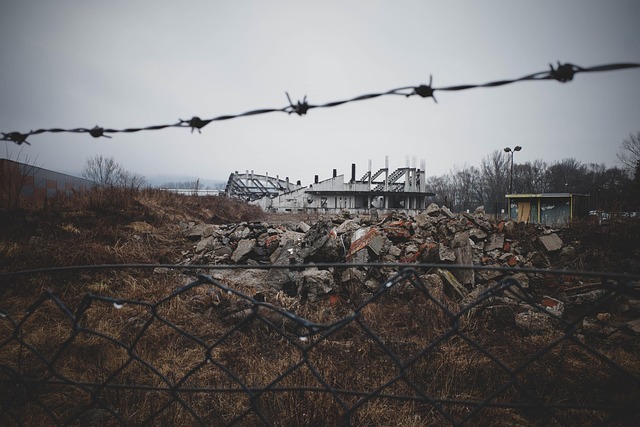Protect Your Real Estate: Sturdy Roofs, Flood Barriers Install

Evaluating flood risk is crucial for real estate decisions, especially with climate change. By analy…….
In a world increasingly shaped by unforeseen events, from natural calamities to man-made crises, the concept of disaster-proofing has emerged as a critical strategy for safeguarding communities, infrastructure, and economies. Disaster-proofing, in its essence, involves preparing and strengthening systems to minimize the impact and recover swiftly from potential disasters. This comprehensive article aims to guide readers through the intricate world of disaster-proofing, exploring its various dimensions, global implications, and the transformative potential it holds. By the end, readers will grasp why this field is not just a necessity but also an opportunity for positive change and sustainable development.
Disaster-proofing is a holistic approach that focuses on mitigating risks and enhancing resilience against disasters. It involves a set of strategies, technologies, and practices designed to protect communities, critical infrastructure, and assets from the devastating effects of natural hazards, environmental changes, and human-induced crises. The core components include:
The concept of disaster-proofing has evolved over centuries, shaped by historical events that left indelible marks on societies. From the construction of ancient flood defenses in Mesopotamia to the development of earthquake-resistant architecture in Japan, humanity has always sought ways to protect itself from natural calamities. However, it is only recently that disaster-proofing has gained prominence as a systematic approach, driven by the increasing frequency and intensity of disasters linked to climate change and geopolitical tensions.
The 2004 Indian Ocean tsunami, for instance, highlighted the critical need for improved early warning systems and community preparedness. Similarly, the 2010 Haiti earthquake exposed the vulnerabilities of poorly constructed buildings and inadequate urban planning. These events catalyzed global efforts to enhance disaster-proofing, leading to advancements in technology, policy, and international cooperation.
Disaster-proofing is significant because it:
Disaster-proofing is a global concern, with countries worldwide adopting strategies to safeguard their populations and assets. The United Nations’ Sustainable Development Goals (SDGs), particularly Goal 11 (Sustainable Cities and Communities), emphasize the importance of building resilient infrastructure and promoting inclusive and sustainable cities. This has led to a surge in international collaborations and knowledge-sharing initiatives focused on disaster-proofing.
While global efforts are evident, regional disparities exist in terms of resources, preparedness, and recovery capabilities. Here are some notable trends:
| Region | Key Trends | Challenges |
|---|---|---|
| Asia-Pacific | Strong focus on early warning systems and disaster risk reduction (DRR) strategies. Countries like Japan and Australia lead in technological advancements and community education. | Limited funding for remote or vulnerable communities, political instability hindering long-term planning. |
| Africa | Increasing awareness of climate change impacts, with efforts to integrate disaster-proofing into national development plans. | Inadequate infrastructure, limited access to technology, and political fragility pose challenges. |
| North America & Europe | Advanced warning systems and robust emergency response plans. Focus on resilient infrastructure and urban planning. | High cost of implementation, political divisiveness impacting policy consensus. |
| Latin America | Striving for better coordination among countries and improved risk assessment tools. | Variability in national priorities, limited funding for disaster preparedness. |
Japan, a country frequently affected by earthquakes, tsunamis, and typhoons, has become a global leader in disaster-proofing. The city of Osaka, for instance, implemented a comprehensive plan to protect against potential flood risks, including raising streets, installing advanced drainage systems, and constructing barrier walls. These measures have significantly reduced the impact of recent floods, showcasing the effectiveness of targeted urban planning.
Disaster-proofing is not just a humanitarian endeavor; it has significant economic implications. The global disaster risk management market, valued at USD 274.5 billion in 2021, is projected to grow at a CAGR of 8.5% from 2022 to 2030 (Grand View Research). This growth is driven by increasing demand for technologies and services that enhance disaster preparedness and resilience.
Technology is at the forefront of revolutionizing disaster-proofing efforts. Some notable advancements include:
One of the primary challenges is securing adequate funding for disaster-proofing initiatives, especially in developing countries with limited fiscal resources. The initial investment costs can be prohibitive, hindering progress despite the long-term benefits.
Disaster-proofing often requires multi-stakeholder collaboration and consensus, which can be challenging due to political differences, power struggles, or a lack of public awareness. Societal attitudes towards risk reduction efforts may also hinder progress, particularly in communities resistant to change.
Climate change introduces an element of uncertainty, making it harder to predict and prepare for future disasters. The increasing frequency and intensity of extreme weather events require adaptable strategies that can evolve with changing conditions.
Disaster-proofing efforts must address social dimensions to ensure equitable outcomes. This involves:
Economic resilience is achieved by integrating disaster-proofing into national economic plans, ensuring:
Environmental considerations are crucial for sustainable disaster-proofing. This includes:
Education plays a pivotal role in disaster-proofing through training programs that equip individuals with the knowledge and skills to respond effectively during emergencies. These programs target various sectors, including:
Awareness campaigns are essential for fostering a culture of disaster preparedness among the general public. These campaigns can be tailored to specific communities, addressing local risks and cultural contexts. Effective communication strategies, including social media and community events, help dispel myths and encourage proactive behavior.
The future of disaster-proofing lies in integrating advanced technologies into every aspect of risk management, from early warning systems to post-disaster recovery. Artificial intelligence (AI), blockchain, and big data analytics have the potential to revolutionize data analysis, resource allocation, and decision-making processes.
International cooperation is vital for sharing best practices, technologies, and resources. Platforms like the Global Platform for Disaster Risk Reduction facilitate knowledge exchange and foster partnerships among nations, organizations, and communities.
Disaster-proofing should be seamlessly integrated into sustainable development agendas, ensuring that infrastructure development, urban planning, and environmental conservation consider disaster risks from the outset. This holistic approach will contribute to building resilient, sustainable communities.
Disaster-proofing is not just a response to emergencies; it is a proactive strategy for creating resilient societies and securing a sustainable future. By integrating technology, strengthening social cohesion, and prioritizing environmental sustainability, we can significantly reduce the impact of disasters and build back better. As the global community continues to grapple with an increasing frequency and intensity of extreme weather events, the importance of disaster-proofing cannot be overstated. It is through collective efforts, innovative technologies, and a holistic approach that we can protect our communities and preserve our shared future.

Evaluating flood risk is crucial for real estate decisions, especially with climate change. By analy…….

Evaluating flood risk is crucial in real estate. Prospective buyers should analyze historical data,…….

Identifying risks through market analysis and historical data is crucial for real estate investments…….

Real estate investors must assess risks like market conditions and property hazards to inform decisi…….

Evaluating flood risk is essential for real estate decisions, guiding mitigation measures and buildi…….

Real estate investors need comprehensive insurance to protect against damage from fires, storms, and…….

Before investing in real estate, assess risks like market volatility and tenant issues. Track econom…….

Real estate professionals assess building vulnerabilities to environmental threats like floods and w…….

Using fire-resistant construction materials in real estate enhances structural integrity, boosts pro…….

Real Estate buyers and investors must evaluate flood risk to protect property values. Assess vulnera…….